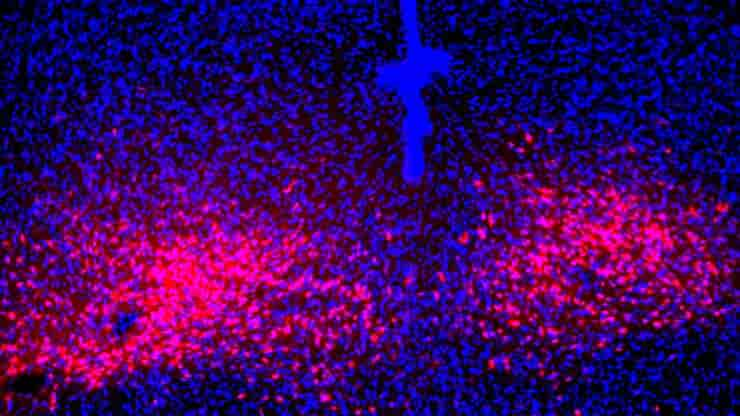Shortness of breath, sweaty palms, overwhelming fear, rapid heart rate — these are the symptoms of a panic attack, which people with panic disorder have frequently and unexpectedly. Making a map of the brain areas, neurons, and connections that mediate these panic attacks could help in the development of more effective panic disorder treatments.
Researchers at the Salk Institute have begun to build that map by uncovering a brain circuit that mediates panic anxiety. This circuit is made up of specialized neurons that send and receive a neuropeptide called PACAP, which is a tiny protein that sends information throughout the brain.
Furthermore, the scientists discovered that PACAP and the neurons that make its receptor could be druggable targets for future panic disorder treatments.
“We’ve been exploring different areas of the brain to understand where panic attacks start. Previously, we thought the amygdala, known as the brain’s fear center, was mainly responsible—but even people who have damage to their amygdala can still experience panic attacks, so we knew we needed to look elsewhere. Now, we’ve found a specific brain circuit outside of the amygdala that is linked to panic attacks and could inspire new panic disorder treatments that differ from current available panic disorder medications that typically target the brain’s serotonin system,”
said senior author Sung Han, associate professor at Salk.
Lateral Parabrachial Nucleus
The researchers started by looking at a portion of the brain called the lateral parabrachial nucleus (PBL) in the pons (part of the brain stem), which is known as the brain’s alert center. Surprisingly, this little portion of the brainstem also regulates breathing, heart rate, and body temperature.
It became clear that the PBL was most likely involved in instilling fear and causing mental and bodily changes. Furthermore, scientists discovered that this brain area produces a neuropeptide known as the master regulator of stress reactions, PACAP (pituitary adenylate cyclase-activating polypeptide).
However, the connection between these pieces remained a mystery, so the team turned to a mouse model of panic attacks to confirm and expand their proposed map.
“Emotional and stress-related behaviors have been associated with PACAP-expressing neurons in the past. By mimicking panic attacks in the mice, we were able to watch those neurons’ activity and discover a unique connection between the PACAP brain circuit and panic disorder,”
said co-first author Sukjae Kang, senior research associate in Han’s lab.
PACAP Neuropeptide Messenger
They discovered that PACAP-expressing neurons got engaged during a panic attack. When triggered, they send PACAP neuropeptide messenger to the dorsal raphe, which contains neurons that express PACAP receptors.
The released PACAP messengers activate those receptor neurons, thereby producing panic-associated behavioral and physical symptoms in the mice.
According to Han, the discovery of the link between panic disorder and the PACAP brain circuit was a significant step forward in mapping panic disorder in the brain. The researchers also discovered that by decreasing PACAP signaling, they could interrupt the flow of PACAP neuropeptides and lessen panic symptoms, which bodes well for the future development of panic disorder-specific therapies.
Not an Anxiety Disorder
Despite the fact that panic disorder is classified as an anxiety disorder, there are significant differences between the two. For example, panic causes many physical symptoms such as shortness of breath, pounding heartbeat, sweating, and nausea, whereas anxiety does not.
Also, panic episodes are uncontrollable and frequently unpredictable, whereas other anxiety illnesses, such as post-traumatic stress disorder (PTSD), are memory-based and have predictable causes.
These differences, says Han, are why it is critical to construct this panic disorder brain map, so that researchers can create therapeutics specially tailored to panic disorder.
“We found that the activity of PACAP-producing neurons in the brain’s parabrachial nucleus is inhibited during anxiety conditions and traumatic memory events; the mouse’s amygdala actually directly inhibits those neurons,”
said Han.
Anxiety vs Panic
It would be fascinating to examine the relationship between anxiety and panic because anxiety appears to be functioning in opposition to the brain circuit that controls panic.
“We need to explain now how people with anxiety disorder have a higher tendency to experience panic attack,”
Han said.
The group is eager to investigate PACAP-expressing neurons and neuropeptides as cutting-edge targets for panic disorder medication. Researchers also want to make a bigger map of where panic disorder is found in the brain so they can learn more about how the dorsal raphe’s neurons that make PACAP receptors send signals and how other parts of the brain that deal with anxiety interact with the PACAP panic system.
Abstract
Panic disorder is characterized by uncontrollable fear accompanied by somatic symptoms that distinguish it from other anxiety disorders. Neural mechanisms underlying these unique symptoms are not completely understood. Here, we report that the pituitary adenylate cyclase-activating polypeptide (PACAP)-expressing neurons in the lateral parabrachial nucleus projecting to the dorsal raphe are crucial for panic-like behavioral and physiological alterations. These neurons are activated by panicogenic stimuli but inhibited in conditioned fear and anxiogenic conditions. Activating these neurons elicits strong defensive behaviors and rapid cardiorespiratory increase without creating aversive memory, whereas inhibiting them attenuates panic-associated symptoms. Chemogenetic or pharmacological inhibition of downstream PACAP receptor-expressing dorsal raphe neurons abolishes panic-like symptoms. The pontomesencephalic PACAPergic pathway is therefore a likely mediator of panicogenesis, and may be a promising therapeutic target for treating panic disorder.
Reference:
- Kang, S.J., Kim, JH., Kim, DI. et al. A pontomesencephalic PACAPergic pathway underlying panic-like behavioral and somatic symptoms in mice. Nat Neurosci (2024). Doi: 10.1038/s41593-023-01504-3
Image: PAC1R-expressing dorsal raphe neurons in the mouse brain (red) serve as the projection targets for PACAP parabrachial neurons to mediate panic-like behavioral and physical symptoms. Credit: Salk Institute
